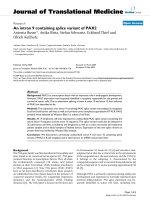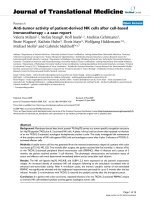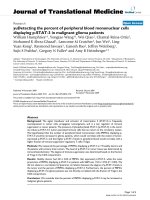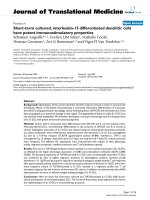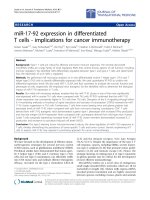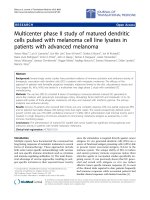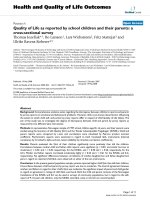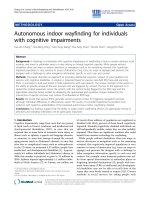báo cáo hóa học: " Neuropeptide Y inhibits interleukin-1b-induced phagocytosis by microglial cells" ppt
Bạn đang xem bản rút gọn của tài liệu. Xem và tải ngay bản đầy đủ của tài liệu tại đây (783.4 KB, 15 trang )
RESEARC H Open Access
Neuropeptide Y inhibits interleukin-1b-induced
phagocytosis by microglial cells
Raquel Ferreira
1*
, Tiago Santos
1
, Michelle Viegas
1
, Luísa Cortes
1
, Liliana Bernardino
1
, Otília V Vieira
1
and
João O Malva
1,2*
Abstract
Background: Neuropeptide Y (NPY) is emerging as a modulator of communication between the brain and the
immune system. However, in spite of increasing evidence that supports a role for NPY in the modulation of
microglial cell responses to inflammatory conditions, there is no consistent information regarding the action of
NPY on microglial phagocytic activity, a vital component of the inflammatory response in brain injury. Taking this
into consideration, we sought to assess a potential new role for NPY as a modulator of phagocytosis by microglial
cells.
Methods: The N9 murine microglial cell line was used to evaluate the role of NPY in phagocytosis. For that
purpose, an IgG-opsonized latex bead assay was performed in the presence of lipopolysaccharide (LPS) and an
interleukin-1b (IL-1b) challenge, and upon NPY treatment. A pharmacological approach using NPY receptor
agonists and antagonists followed to uncover which NPY recep tor was involved. Moreover, western blotting and
immunocytochemical studies were performed to ev aluate expression of p38 mitogen-activated protein kinase
(MAPK) and heat shock protein 27 (HSP27 ), in an inflammatory cont ext, upon NPY treatment.
Results: Here, we show that NPY inhibits phagocytosis of opsonized latex beads and inhibits actin cytoskeleton
reorganization triggered by LPS stimulation. Co-stimulation of microglia with LPS and adenosine triphosphate also
resulted in increased phagocytosis, an effect inhibited by an interleukin-1 receptor antagonist, suggesting
involvement of IL-1b signaling. Furthermore, direct application of LPS or IL-1b activated downstream signaling
molecules, including p38 MAPK and HSP27, and these effects were inhibited by NPY. Moreover, we also observed
that the inhibitory effect of NPY on phagocytosis was mediated via Y
1
receptor activation.
Conclusions: Altogether, we have identified a novel role for NPY in the regulation of microglial phagocytic
properties, in an inflammatory context.
Keywords: microglia, neuropeptide Y, HSP27, p38, inflammation, phagocytic cups
Background
Microglia are the reside nt immunocompetent cells of
the central nervous system (CNS), responsible for
mounting appropriate responses to inj uries such as
trauma, ischemia, brain tumors and neurodegenerative
diseases that target the brain parenchyma [1,2]. More-
over, microglia displa y a wide range of receptors that
enable the recognition of pathogens or cell damage-
related antigens, thereby promoting phagocytosis and
removal of cell debris [3]. Phagocytosis is a coordinated
process, triggered b y environmental signals that requires
a dynamic actin cytoskeleton rearrangement and a
plethora of receptor signaling pathways [4].
The role of microglia in inflammation has been
experimentally dissected using lipopolysaccharide (LPS)
stimulation, which mimics Gram-negative infection,
through the activation of Toll-like receptor 4 (TLR4).
While microglia randomly scan the healthy brain par-
enchyma, activated cells undergo significant morpholo-
gical changes and an e nsuing targeted moveme nt
toward the site of injury, where they release both neuro-
trophic and neuroto xic factor s [2,5]. Amo ngst the
* Correspondence: ;
1
Center for Neuroscience and Cell Biology, University of Coimbra, Coimbra,
Portugal
Full list of author information is available at the end of the article
Ferreira et al. Journal of Neuroinflammation 2011, 8:169
/>JOURNAL OF
NEUROINFLAMMATION
© 2011 Ferreira et al; licensee BioMed Central Ltd. This is an Open Access article distributed under the terms of the Creative Commons
Attribution License (http://c reativec ommons.org/licenses/by/2 .0), which permits unre stricted use, distribution, and reprod uction in
any medium, provided the original work i s properly cited.
inflammatory mediators initially secreted, interleukin-1b
(IL-1b) is particularly relevant given its involvement in
excitotoxicity, ischemia, brain trauma and cell death
[6-8]. Rece ntly, we have describ ed a chemokinetic effect
of IL-1b on microglial motility, whereby IL-1b stimu-
lates microglial motility with involvement of p3 8 MAPK
signaling [9].
Growing evidence support s involvement of neuropep-
tide Y (NPY) in the modulation of the immune system,
with effects on macrophage, B and T cell function; as
well as dendritic cell stimulatory ability [10]. H owever,
itsroleinphagocytosisremains contro versial. Neuro-
peptide Y (NPY) is widely distributed within the pe riph-
eral and central nervous systems and has well defined
physiological roles that include regulation of blood pres-
sure, circadian rhythms, feeding behavior, memory pro-
cessing and learning [11].
In this context, our objective was to unravel the role
of NPY in the modulation of Fc recept or-mediated pha-
gocytosis (the best characterized phagocytic receptor) by
activated microglial cells during inflammation. Micro-
glial cells have specific signaling systems that regulate
rapid rearrangement of the actin cytoskeleton enabling
the cell to phagocytose when needed. Here, we report
an inhibitory effect of NPY, acting via Y
1
receptors, on
IL-1b-stimulated phagocytosis, a process accompanied
by p38 MAPK and HSP27 activation. Our results high-
light the modulation of phagocytosis as part of the puta-
tive anti-inflammatory role of NPY, supporting the
importance of this neuropeptide in the regulation of
important m icroglial responses to danger signals in the
brain.
Methods
Cell line cultures
A murine N9 microglia cell line ( a kind gift from Pro-
fessor Claudia Verderio, CNR Institute of Neuroscience,
Cellular and Molecular Pharmacology, Milan, Italy) was
growninRPMImediumsupplementedwith30mM
glucose (Sigma, St. Louis, MO, USA), 100 U/ml penicil-
lin and 100 μg/ml str eptomycin (GIBC O, Invitrogen,
Barcelona, Spain). Cells were kept at 37°C in a 95%
atmospheric air and 5% CO
2
humidified atmosphere.
Numbers of viable cells were evaluated by counting try-
pan blue-exclud ing cells that were then plated at a den-
sityof2×10
4
cells per well i n 24-well trays, or plated
at a density of 5 × 10
5
cells per well in 6-well tra ys (for
remaining experiments).
Cell treatment for phagocytosis studies included the
following incubation setup: NPY (human, rat/amidated
sequence) (1 μM) (Bachem, Bubendorf, Switzerland),
LPS (100 ng/ml) (Sigma), ATP ( 1 mM) (Sigma) , IL-1b
(1.5 ng/ml) (R&D System, Minneapolis, MN, USA), IL-
1ra (150 ng/ml) (R&D Systems), SB239063 (chemically
synthesized) (20 μM) (Tocris, Brist ol, UK), Y
1
receptor
agonist [Leu31, Pro34]NPY (porcine, amidated
sequence) (1 μM) (Bachem), Y
1
receptor antagonist
BIBP3226 (1 μM, in water) (Bachem), Y
2
receptor
antagonist BIIE0246 (1 μ M, in 0.06% DMSO) (Tocris)
and Y
5
receptor antagonist L-152,804 (1 μM, in 0.2%
DMSO) (Tocris), for 6 hrs. ATP, SB239063 and all
receptor antagonists were added 30 min prior to cell
treatment and maintained during the course of
experiments.
Generation of an N9 murine microglia cell line stably
expressing human FcgRIIA
The N9 microglia cell line expresses a variety of Fc
receptors. To overcome this issue, and due to the
absence of good antibodies against Fc receptors, we
decided to constitutively express human FcgRIIA tagged
with c-myc. The protocol for generation of N9 cells
expressing FcgRIIA, retroviru s production, cell infection
and se lection was adopted from [12,13]. Briefly, human
FcgRIIA tagged with C-terminal myc-His6 was sub-
cloned into the retroviral vector pBABE-puro, which
contains a resistance gene to puromycin. The viruses
were produced by tranfecting the human Phoenix gag-
pol packaging cell line with the retroviral plasmid
together with incorporation of the vesicular stomatitis
virus G protein. Because of the incorporation of the
vesicular stomatitis virus G prot ein into the virus envel-
ope, these v iral particles a re able to infect almost any
dividing mammalian cell. For infection, 1.5 × 10
5
cells
were incubated with 1 ml of retrovirus, pseudotyped
with the VSV-G envelope protein, expressing the Fc-
receptor in the presence of 4 μg/ml polybrene (Sigma),
at 32°C. After 24 hrs of incubation, the medium was
changed and the infection procedure repeat ed. Twenty -
four hours later, cells were trypsinized and seeded into a
6-well tray in the presence of 7 μg/ml pur omycin
(Sigma). Selection was done for another 48 hrs.
Phagocytosis assay
Beads were opsonized with rabbit IgG (1 μg/ml) (Sigma)
or with human IgG (0.5 μg/ml) (Sigma, St. Louis, MO,
USA) (for the phagocytic cup studies) under constant
agitation at 8 rpm, overnight at 4°C. Beads were then
resuspended in modified RPMI medium, without
NaHCO
3
, and distributed at a density o f 1 × 10
5
beads
per well. After 40 min of incubation (or 20 min, for
phagocytic cup studies), cells were washed with PBS and
fixed with 4% paraformaldehyde (PFA). Extracellular
and/or adherent beads were labeled with secondary anti-
body Alexa Fluor 594 donkey anti-rabbit or with Cy5
donkey anti-human (Molecular Probes, Oregon, USA),
1: 500, in PBS. For each field, three photomicrographs
were acquired in order to capture stained nuclei (in
Ferreira et al. Journal of Neuroinflammation 2011, 8:169
/>Page 2 of 15
blue), extracellular and/or adherent beads (in red) and
tot al number of beads (differential interference con trast
image). The location of each bead was analyzed by com-
paring the three separate images simultaneously. Only
beads without fluorescent labeling were considered a s
internalized particles. For nuclear labeling, cell prepara-
tions were stained with Hoechst 33342 (2 μg/ml) (Mole-
cular Probes) in PBS, for 5 min at room temperature
(RT). Coverslips were then mounted in Dako fluorescent
medium (Dakocytomation Inc., California, USA). Fluor-
escent images were acquired using an Axiovert 200 M
microscope, equipped with an AxiocamHRm and Plan-
ApoChromat 40 ×/1.30 oil objective (Göttingen,
Germany).
Immunocytochemistry
Cells were fixed with 4% PFA (Sigma) and unspecific
binding was prevented by incubating cells in a 3% BSA
and 0.3% Triton X-100 solution (all from Sigma) for 30
min, at RT. Cells were kept overnight at 4°C, in 0.3%
BSA and 0.1% Triton X-100 primary antibody solution,
then washed with PBS, and incubated for 1 hr at RT
with the corresponding secondary antibody.
Antibodies used were: rabbit polyclonal a nti-phos-
phorylated HSP27 (1:400) (Cell Signaling Tech, Beverly,
MA, USA); mouse monoclonal anti-c-myc (1:2000) (Cell
Signaling Tech,); rat monoclonal anti-CD11b (1:1000)
(AbD Serot ec, Oxford, UK); Alexa Fluor 594 goat anti-
rabbit; Alexa Fluor 488 donkey anti-rabbit; Alexa Fluor
594 donkey anti-mouse; Alexa Fluor 488 goat anti-rat
(all 1:200 in PBS, from Molecular Probes).
Membrane ruffling was observed using a marker for
filamentous actin, phalloidin. Cells were incub ated for 2
hrs in phalloidin-Alexa Fluor 594 conjugate, 1:100
(Molecular Probes) in PBS, at RT, protected from light.
For nuclear labeling, cell preparations were stained
with Hoechst 33342 (2 μg/ml) (Molecular Probes,
Eugene, Oregon, USA) in PBS, for 5 min at RT and
mounted in Dakocytomation fluorescent medium
(Dakocytomation Inc., California, USA). Fluorescent
images were acquired using a confocal microscope, with
a Plan-ApoChromat 63 ×/1.40 oil objective (LSM 510
Meta, Carl Zeiss, Göttingen, Germany).
Western blotting
Cells were incubated with lysis cocktail solution (137
mM NaCl, 20 mM Tris-H Cl, 1% Triton X-100, 10% gly-
cerol, 1 mM phenylmethylsulfonyl fluoride, 10 μg/ml
aprotinin, 1 μg/ml leupeptin, 0.5 mM sodium vanadate
(all from Sigma), pH 8.0). After gentle homogenization,
the total amount of protein was quantified using the
BCA method (Thermo Scientific, Rockford, USA). After-
wards, samples were loaded onto 10% acrylamide/bisa-
crilamide gels (BioRad, Hercules, CA, USA). Proteins
were separated by SDS-PAGE using a bicine/SDS
(Sigma) electrophoresis buffer (pH 8.3) and then trans-
ferred to PVDF membranes (Millipore) with a 0.45-μm
pore size, under the following conditions: 300 mA, 90
min at 4°C in a solution containing 10 mM CAPS
(Sigma) and 10% methanol (VWR Inte rnational S.A.S.
France), pH 11.0) (pro tocol adapted from [14]). For
detection of phosphorylated proteins, membranes w ere
blocked in Tris-buffer saline (TBS) containing 5% BSA,
0.1% Tween
®
20 (Sigma) for 1 hr, at RT, and then incu-
bated overnight at 4°C with the primary antibody diluted
in blocking solution.
The following primary antibodies were used: rabbit
polyclonal anti-phosphorylated HSP27 (1:1000), rabbit
polyclonal anti-HSP27 (1:1000) (both from Cell Signal-
ing) and mouse monoclonal anti-c-myc (1:600) (Santa
Cruz Biotechnology Inc.). After rinsing three times with
TBS-T, membranes were incubated for 1 hr at RT with
an alkaline phosphatase-linked secondary antibody anti-
rabbit IgG 1:20,000 or anti-mouse IgG 1:10,000 in
blocking solution (GE H ealthcare UK Limited, Buckin-
ghamshire, UK). Protein immunoreactive bands were
visualized in a Versa-Doc Imaging System (Model 3000,
BioRad Laboratories, CA, USA), after incubation of the
membranes with enhanced chemofluorescence reagent
(GE Healthcare UK Limited) for 5 min.
Data analysis
Statistical analysis was performed using GraphPad Prism
5.0 (GraphPad Software , San Dieg o, CA). Statistical sig-
nificance was considered relevant for p values < 0.05
using one-way analysis of variance followed by Bonfer-
roni post hoc test for comparison among experimental
settings and Dunnett post hoc test for comparison with
control condition. Data are presented as mean ± stan-
dard error of mean (SEM). For every immunocytochem-
ical analysis, 5 independent microscopy fields were
acquired per coverslip (about 50 cells per field). Every
experimental condition was tested in three sets of inde-
pendent experiments (n), unless stated otherwise, and
performed in duplicate.
Results
NPY inhibits Fc receptor-mediated phagocytosis by
microglial cells
The murine N9 microglia cell line was used to discern
the role of NPY in LPS-induced phagocytosis. LPS is a
component of Gram-negative bacterial outer membranes
and binds to the CD14/TLR4/MD2 receptor comple x
present at the microglial cell membrane, triggering sev-
eral signaling cascades [15]. We have previously used
this cell line to dissect the effects of LPS over other
microglial physiological responses, such as production of
inflammatory mediators [e. g. nitric oxide (NO) and IL-
Ferreira et al. Journal of Neuroinflammation 2011, 8:169
/>Page 3 of 15
1b)] and migration/motility. We observed that NPY, act-
ing via the Y
1
receptor, inhibited LPS-induced micro-
glial activation [9,16].
Prior to phagocytosis, microglial cells were challenged
with LPS (100 ng/ml) and/or NPY (1 μM) for 6 hrs.
IgG-opsonized latex beads were added at a density of 1
×10
5
perwellandallowedtobeingestedfor40min.
After fixation, non-ingested beads were immunolabeled
in order to distinguish extracellular and adherent part i-
cles from those internalized. Therefore, phagocytosed
beads were distinguished from non-phagocytosed beads
by means of fluorescent labeling (no ne versus red,
respectively) (Figure 1A). LPS significantl y increased
bead phagocytosis, while NPY inhibited this effect
(mean
CTR
= 100 ± 29.46%; mean
LPS
= 730.50 ± 74.02%;
mean
LPS+NPY
= 250 ± 23.47%; mean
NPY
= 195.60 ±
79.83%; p < 0.001) (Figure 1B). In Figure 1A, representa-
tive photomicrographs illustrate the inhibitory effect of
NPY over LPS-stimulated microglia phagocytosis.
LPS-induced phagocytosis involves IL-1b signaling
LPS and ATP co-administration induces a massive
release of IL- 1b [17-20]. We have previously shown that
murine N9 microglial cells release the biologically active
form of IL-1b upon LPS and ATP challenge [16]. LPS
activates TLR4, triggering several inflammatory
responses, while ATP exposure stimulates P2X
7
recep-
tors, leading to opening of a non-selective pore that
allows massive calcium entry and, consequently, activa-
tion of interleukin converting enzyme (ICE) [21,22]. In
our study, LPS (100 ng/ml) plus ATP (1 mM) signifi-
cantly stimulated opsonized beads uptake (mean
CTR
=
100 ± 27.91%; mean
LPS+ATP
= 699.50 ± 58.33%; p <
0.001) (Figure 2). Interestingly, this effect was comple-
tely abolished by interleukin-1b recepto r antagonist (IL-
1ra) treatment (150 ng/ml), sug gesting involvement of
IL-1b in LPS-plus-ATP-induced microglial phagocytosis
(mean
LPS+ATP
= 699.50 ± 58.33%; mean
LPS+ATP+IL-1ra
=
113.90 ± 19.02%; p < 0.001). Accordingl y, IL-1b (1.5 ng/
ml) significantly increased microglial cell phagocytosis,
which was also inhibited by exposur e to IL-1ra (mean
IL-
1b
= 685.90 ± 36.37%; mean
IL-1b+IL-1ra
= 198 ± 37.10%; p
< 0.001) (Figure 2B). In Figure 2A, representative photo-
micrographs illustrate a stimulatory effect of IL-1b on
microglial phagocytosis, as well as LPS and ATP, and an
inhibitory effect of IL-1ra over these events.
NPY inhibits IL-1b-stimulated phagocytosis via Y
1
receptor activation
In accordance with the previous experiments, microglial
cells were then treated with IL-1b (1.5 ng/ml) and NPY
(1 μM). As a result, we observed that NPY inhibited IL-
1b-induced phagocytosis (mean
IL-1b
= 685.90 ± 36.37%;
mean
IL-1b+NPY
= 115.40 ± 37.99%; p < 0.001) (Figure 3A
and 3B). Moreover, to assess through which receptor
NPY inhibits microglial phagocytic activity, cells were
treated with the Y
1
receptor agonist [Leu
31
,Pro
34
]NPY
(1 μM) or the Y
1
recept or antagonist BIBP3226 (1 μM).
Y
1
receptor activation resulted in inhibition of IL-1b-
induced phagocytosis while the Y
1
receptor antagonist
blocked the effect induced by NPY (mean
IL-1b+[Leu, Pro]
NPY
= 213.70 ± 20.37%; mean
IL-1b+NPY+BIBP3226
= 705.90
± 23.89%; p < 0.001). Involvement of the other main
NPY-stimulated receptors in brain was excluded using a
combination of selective antagonists for Y
2
receptor
(BIIE0246, 1 μM) and for Y
5
receptor (L152-804, 1 μM),
since, in t he presence of both antagonists, NPY was still
able to inhibit phagocytosis (mean
IL-1b+NPY+BIIE0246+L152-
804
= 135.70 ± 32.65%) (Figure 3A and 3B).
LPS-stimulated phagocytosis requires p38 signaling
We have previously observed that p 38 MAPK signaling
pathway is activated during actin cytoskeletal assembly.
Moreover, p38 inhibiti on dampens this process. Accord-
ingly, we hypothesized that p38 was involved in phago-
cytosis, a very well coordinated process that requires
dynamic arrangement of actin filaments [4]. For that
matter, we decided to investigate whether the NPY inhi-
bitory effect on phagocytosis is caused by any visible
alterations in the reorganization of the actin cytoskele-
ton, using phalloidin staining. Cell morphology was
assessed us ing the labeling with the surface marker
CD11b, which is expressed by microglial cel ls [23] (Fig-
ure 4). Upon LPS challenge, actin (in red) actively poly-
merized and formed exuberant and flexible structures
named membrane ruffles; this feature can contribute, at
least in part, to the increased rate of phagocytosis.
Untreated cells or cells otherwise treated with NPY
mainly exhibited cortical actin. We would like to stress
that there was a huge reduction in membrane ruffles on
NPY-treated cells compared with LPS-treated cells (Fig-
ure 4). Thus, the effect of NPY on phagocytosis upon
LPS challenge can be attributed, at least partially, to
changes in actin cytoskeleton rearrangements. Accord-
ingly, in the presence of the p38 inhibitor SB239063 (20
μM), actin cytoskeleton morphology resembled that of
untreated or NPY-treated cells (Figure 4).
In addition, we observed that in the presence of the
p38 inhibitor, LPS-stimulated phagocytosis was reduced
and was similar to untreated cells (mean
CTR
= 100 ±
0.01%; mean
LPS
= 740.5 ± 246%; mean
LPS+SB239063
=118
± 19.45%; mean
SB239063
= 147.1 ± 63.81%; p < 0.05) (Fig-
ure 5A and 5B). Heat shock protein 27 (HSP27) is a
downstream target of p38, also implicated in the control
of actin polymerization [24]. Herein, we observed by
western blot and immunocytochemistry that both LPS
and IL-1b significantly induced HSP27 phosphorylation
(mean
CTR
= 100%; mean
LPS
=122.5±7.25%;mean
IL-1b
Ferreira et al. Journal of Neuroinflammation 2011, 8:169
/>Page 4 of 15
Figure 1 NPY inhibits bead phagocytosis by microglial cells. (A) Represe ntative photomicrogra phs illustrate the inhibi tory effect of NPY on
LPS-induced phagocytosis. (B) LPS (100 ng/ml) increased bead phagocytosis, while NPY (1 μM) inhibited this effect. Data are expressed as mean
± SEM (n = 3-5) and as a percentage of control (***p < 0.001, using Bonferroni’s Multiple Comparison Test). Scale bar 10 μ m.
Ferreira et al. Journal of Neuroinflammation 2011, 8:169
/>Page 5 of 15
Figure 2 LPS-induced phagocytosis is mediated by IL-1b signaling. (A) Representative photomicrographs illustrate the inhibitory effect of IL-
1b, or LPS+ATP alone or with co-treatment with IL-1ra. (B) LPS (100 ng/ml) and ATP (1 mM) co-administration significantly induced bead
phagocytosis. This effect was prevented by IL-1ra application (150 ng/ml) suggesting involvement of IL-1b. Direct application of IL-1b (1.5 ng/ml)
increased phagocytosis and was completely inhibited by IL-1ra. Data are expressed as mean ± SEM (n = 3-5) and as a percentage of control
(***p < 0.001, using Bonferroni’s Multiple Comparison Test). Scale bar 10 μm.
Ferreira et al. Journal of Neuroinflammation 2011, 8:169
/>Page 6 of 15
Figure 3 NPY inhibits IL-1b-induced phagocytosis via Y
1
receptor activation. (A) Representative photomicrographs illustrate the inhibitory
effect of NPY acting via Y
1
receptor on IL-1b-induced cell phagocytosis. (B) Microglial cells were stimulated with IL-1b (1.5 ng/ml) and treated
with NPY (1 μM). As NPY inhibited IL-1b-induced phagocytosis, a Y
1
receptor agonist [Leu
31
, Pro
34
]NPY (1 μM) and a Y
1
receptor antagonist
BIBP3226 (1 μM) were used to determine the effect of Y
1
R activation on IL-1b-induced phagocytosis. The involvement of other NPY receptors
was ruled out with the use of antagonists for the Y
2
receptor (BIIE0246, 1 μM) and the Y
5
receptor (L152-804, 1 μM). Data are expressed as mean
± SEM (n = 3-5) and as a percentage of control (***p < 0.001, using Bonferroni’s Multiple Comparison Test). Scale bar 10 μ m.
Ferreira et al. Journal of Neuroinflammation 2011, 8:169
/>Page 7 of 15
Figure 4 NPY inhibits LPS-induced actin cytoskeleton reorganization. Representative confocal photomicrographs were taken to assess the
role of LPS on rearrangement of the actin cytoskeleton. Microglial cells treated with LPS (100 ng/ml) showed significant membrane ruffling,
while NPY (1 μM) reduced this effect. Moreover, microglial cells treated with LPS (100 ng/ml), in the presence of SB239063, showed a
cytoskeleton rearrangement similar to that of untreated cells. Cells were stained for actin (in red), CD11b (in green) and Hoechst 33342 (nuclei in
blue). Scale bar 10 μm.
Ferreira et al. Journal of Neuroinflammation 2011, 8:169
/>Page 8 of 15
Figure 5 LPS-stimulated phagocytosis requires p38 activation. (A) Representative photomicrographs depict involvement of p38 signaling in
LPS-induced phagocytosis. (B) Microglial cells were treated with LPS (100 ng/ml). Application of a p38 inhibitor, SB239063 (20 μM), significantly
inhibited LPS-induced phagocytosis. Data are expressed as mean ± SEM (n = 3) and as a percentage of control (*p < 0.05; **p < 0.01, using
Bonferroni’s Multiple Comparison Test). Scale bar 10 μm.
Ferreira et al. Journal of Neuroinflammation 2011, 8:169
/>Page 9 of 15
Figure 6 NPY inhibits LPS- and IL-1b-induced HSP27 phosphorylation. (A) Densitometric quantification of western blots shows that
microglial cells, treated with LPS (100 ng/ml) or with IL-1b (1.5 ng/ml) showed increased levels of phosphorylated HSP27, while NPY (1 μM)
clearly inhibited this effect. Moreover, cells treated with the p38 inhibitor SB239063 (20 μM) showed decreased expression similar to that of
untreated cells. (B) Representative confocal photomicrographs demonstrate increased phosphorylation of HSP27 upon inflammatory challenge.
Cells were stained for phosphorylated HSP27 (in red), CD11b (in green) and Hoechst 33342 (nuclei in blue). Data are expressed as mean ± SEM
(n = 4-5) and as a percentage of control (*p < 0.05, using Bonferroni’s Multiple Comparison Test). Scale bar 10 μm.
Ferreira et al. Journal of Neuroinflammation 2011, 8:169
/>Page 10 of 15
= 146.1 ± 14.35%; p < 0.05), while a p38 inhibitor
(SB239063) inhibited this effect (mean
LPS+SB239063
= 93.8
± 9.21%; mean
IL-1b+SB239063
=88.17±8.48%;p<0.05),
supporting the involvement of p38 signaling in HSP27
activation (Figure 6). Additionally, NPY inhibited LPS-
and IL-1b-induced HSP27 phosphorylation (mean
LPS
+NPY
=103.8±2.74%;mean
IL-1b+NPY
= 104.3 ± 13.58%;
mean
NPY
= 109.9 ± 8.13%; p < 0.05) (Figure 6A). In Fig-
ure 6B, H SP27 labeling (in red) is significantly increased
in LPS- and IL-1b-activated cells compared to untreated
cells. To visualize cell morphology, we labeled cells with
the surface marker CD11b, which is known to be
expressed by microglial cells [23].
Interestingly, in accordance wit h the increased expres-
sion of phosphorylated p38 and HSP27 i n LPS or IL-1b-
treated cells, we also observed that HSP27 co-localized
with the actin cup surrounding beads in the process of
phagocytosis. HSP27 expression in the phagocytic cups
observed in LPS-treated cells was clearly potentiated
when compared to phagocytic cups in non-stimulated
cells ( showing a faint but still present staining of
HSP27) (Figure 7).
NPY reduces FcgRIIA expression on LPS- and IL-1b-
stimulated microglia
To further evaluate the role of NPY on FcR-mediated
phagocytosis, we transfected N9 microglial cells in order
to stably expresses human FcgRIIA, a receptor mainly
involved in the phago cytosis of opsonized particles [25].
In that sense, we observed that upon LPS or IL-b chal-
lenge, the derived N9 microglia cell line significantly
increased FcgRIIA protein levels, quantified by western
blotting (mean
CTR
= 100 ± 0.01%; mean
LPS
= 128.30 ±
7.13%; mean
IL-1b
= 123.70 ± 7.69%; n = 4, p < 0.05)
(Figure 8A). In the presence of NPY, stimulated cel ls
displayed a reduction of Fc gRIIA expression levels, indi-
cating that NPY may inhibit phagocytosis by decreasing
the level of receptors on the plasma membrane
(mean
LPS+NPY
= 97.72 ± 6.30%; mean
IL-1b+NPY
=93.81±
6.18%; n = 4, p < 0.05).
In addition, using immunocytochemistry, we observed
that both LPS and IL-b increased FcgRIIA expression
levels in microglial cells. Moreover, NPY treatment sig-
nificantly reduced FcgRIIA expression on either LPS- or
IL-b-stimulated cells, to levels similar to untreated cells
(Figure 8B).
Discussion
Microglial cells play a pivotal role in immunosurveillance
in the CNS, acting as resident macrophages in the brain
parenchyma [1,7,26,27]. In recent years, increasing evi-
dence has suggested that NPY is an important regulator of
immune system function, wit h different resul ts o btained
concerning the role of this peptide in phagocytosis
[10,28-32]. In our study, we used an experimental model
of microglial phagocytic activity induced by lipopolysac-
charide (LPS) to evaluate the role of NPY on Fc receptor-
mediated phagocytosis. Microglial cells are constantly
prowling the brain environment and are able to efficiently
identify invading pathogens by expressing a vast array of
pattern recognition receptors, such as Toll-like receptors
(TLRs) [1,2]. Among the different members of the TLR
family, TLR4 i s the best characterized. TLR4 recognizes
LPS, a component of the outer membrane of Gram-nega-
tive bacteria [33]. Importantly, LPS-induced phagocytosis
in macrophages requires TLR4 signaling since downregu-
lation of TLR4 expression by RNAi signific antly compro-
mises the phagocytic activity of these cells [34].
Accordingly, we show that LPS significantly enhances
microglial Fc receptor-mediated phagocytosis while NPY,
via Y
1
receptor activation, inhibits this effect. Moreover,
we observed that LPS-induced phagocytosis of IgG-opso-
nized beads is a process that occurs with the involvement
of IL-1b and downstream acti vation of the p38 mitogen-
activated protein kinase (MAPK) pathway.
In lig ht of our previous results, showing involvement
of interleukin-1b (IL-1b) in LPS-stimulated microglial
cell activation and motility, we proposed to uncover a
role for IL-1b in LPS-stimulated phagocytosis. Accord-
ingly, LPS and ATP co-administration stimulated phago-
cytosis and this effect was abolished by IL-1ra treatment,
suggesting that the effect of LPS is, at least in part,
mediated by IL-1b. Interesti ngly, we would like to
emphasize that IL-1b is vital for resolving bacterial
infection caused by various pathogens [35,36]. Bacterial
infection results in an increased release of IL-1b,which
enhances phagocytic ce ll recruitment to infection sites
[36-38]. Moreover, during LPS -induced phagocytosis,
the production of the endogenous anti-inflammatory
cytokine IL-1ra is increased to balance possible cytotoxic
effects of IL-1b on neighboring tissues [39].
In vitro studieshavedescribedaroleforNPYinthe
modulation of various functions of macrophages, such
as adherence, chemotaxis, phagocytosis a nd superoxide
anion production [32,40-43]. Furthermore, we have also
identified a role for NPY in inhibition of nitric oxide
production and motility/migration by microglial cells
[9,16]. In the present study, we show that NPY inhibits
IL-1b-induced phagocytosis via Y
1
receptor activation.
In agreement with our results, NPY has been shown to
decrease phagocytosis in older mice. Interestingly, in
these animals the release of IL-1b from peritoneal
macrophages was higher than that observed in younger
animals, and NPY also inhibited this effect [32]. The
role of NPY in regulation of phagocytosis seems to
depend also upon the particular pathogen studied and
their mechanisms o f replication. In vitro studies have
shown that NPY inhibits engulfment of Leishmania
Ferreira et al. Journal of Neuroinflammation 2011, 8:169
/>Page 11 of 15
Figure 7 HSP27 is present at th e phagocytic cup. R epresentative confocal photomicrograp hs were taken to assess the role of LPS on
formation of the phagocytic cup. Untreated microglial cells (left panel) and cells treated with LPS (100 ng/ml) (right panel) revealed formation of
a cup-shaped structure engulfing an opsonized bead (open arrowhead). LPS treatment induced increased labeling of phosphorylated HSP27
throughout the cell cytoplasm and nucleus as well as in the cup. Cells were stained for phosphorylated HSP27 (in green), actin (in red) and
Hoechst 33342 (nuclei in blue). Opsonized beads are labeled in cyan blue. Scale bar 10 μm.
Ferreira et al. Journal of Neuroinflammation 2011, 8:169
/>Page 12 of 15
major b y a mono cyte/macrophage murine cell line [43].
Since inf ection of phagocytes is a crucial step for repli-
cation of Leishmani a major, inhibiting phagocytosis
results in a protective action [44]. Moreover, the effect
of NPY may vary according to other parameters (e. g.
concentration, target cell, stimulus) and depends on
interactions between different cell types [30-32,45,46].
Recognition of pathogen-associated molecular patterns
triggers TLR signali ng through myeloid differentiatio n
primary response gene 88 (MyD88) adapter molecule
and activation of mitogen-activated protein kin ases
(MAPKs) and NF-B [47]. Furthermore, p38 MAPK sig-
naling has been implicated in phagocytosis carried out
by murine macrophages [48] and Drosophila hemocytes
[49]. Since cytoskeleton remo deling is vital for cell pha-
gocytosis, p38 could be a putativ e molecular target to
discern which signaling pathways are involved in this
process. The re are several reports implicating p38 acti-
vation in phagocytosis, either as a consequence of pha-
gocytosis or as a necessary step to initiate this process
[48-50]. In fact, Blander and colleagues have sh own that
the use of selective p38 inhibitors impairs t he ability of
macrophages to phagocyte E. coli [51]. Moreover, upon
activation, phosphorylated p38 translocates to the
nucleus and phosphorylates MAPK-activated protein
kinase 2 (MK2) [52]. Cells def icient in MK2 are unable
to regulate actin reorganizatio n and, therefore, to form
membrane protrusions [53]. MK2 modulation of p hago-
cytosis may occur through the small heat shock protein
HSP25/27, since it regulates actin polymerization [54].
Phagocytos is can be triggered by different signals that
are recognized by different receptors, triggering diff erent
sig nali ng cascades. In o ur study, we focused on the role
of NPY on Fc receptor-mediated phagocytosis, the main
phagocytic process occurring in macrophages, a cell
type that shares close functional and morphological
resemblances to microglia. In fact, NPY reduced expres-
sion of Fc receptor on the cell surface of stimulated
microglia, thereby restraining the phagocytic capacity of
these cells under inflammatory challenge. In this regard,
NPY may modulate the phagocytic process in order to
maintain microglial activity close to a physio logical rest-
ing/surveying state, even in the presence of a stimula-
tory/activating agent.
However, we should emphasize that our findings are
limited to the modulation of Fc receptor-mediated phago-
cytosis. Nevertheless, our data further highlight th e puta-
tive anti-inflammatory and anti-phagocytic role of NPY,
and broaden our knowledge of the therapeutic value of
this neuropeptide in the treatment of CNS disorders.
Conclusions
In an inflammatory context, microglial cells become
strongly activated through a process that involves
Figure 8 NPY decreases FcgRIIA-myc expression on microglial
cells. (A) Densitometric quantification of western blots shows that
microglial cells treated with LPS (100 ng/ml) or with IL-1b (1.5 ng/
ml) increased FcgRIIA expression levels while NPY treatment (1 μM)
significantly inhibited this effect. (B) Representative confocal
photomicrographs demonstrate an inhibitory effect of NPY on LPS-
or IL-1b-induced FcgRIIA expression. Cells were stained for FcgRIIA-
myc (in red), CD11b (in green) and Hoechst 33342 (nuclei in blue).
Data are expressed as mean ± SEM (n = 4) and as a percentage of
control (*p < 0.05, using Bonferroni’s Multiple Comparison Test).
Scale bar 10 μm.
Ferreira et al. Journal of Neuroinflammation 2011, 8:169
/>Page 13 of 15
downstream p38 MAPK and HSP27 phosphorylation,
and increase their ability to phagocytose. In our study,
NPY acting throu gh Y
1
receptors significantly restrained
microglial activation, thereby inhibiting LPS-induced Fc
receptor-mediated phagocytosis. Under physiological
conditions, resting-like cells show substantially low
levels of phosphorylated p38 MAPK and HSP27, thus
presenting limited phagocytic ability. The role of NPY
in the regulation of mic roglial cell phago cytosis is p ro-
mising since this neuropeptide d emonstrates a strong
inhibitory action on activated microglia-re lated
responses. While scientific research is commonly con-
ducted towards the regulation or improvement of
microglial phagocytosis, which appears limited or dys-
functional in chronic neurodegenerative diseases and
ageing [55], our findings could potentially lead to the
development of new therapeutic targets aiming at the
restriction of phagocytosis in pathological conditions
occurring in the brain.
List of abbreviations
ATP: adenosine triphosphate; IL-1β: interleukin-1beta; IL-1ra: interleukin-1
receptor antagonist; LPS: lipopolysaccharide; MAPK: mitogen-activated
protein kinase; NPY: neuropeptide Y; SB239063, p38 inhibitor; TLR4: Toll-like
receptor 4.
Acknowledgements
The authors wish to thank Prof. Claudia Verderio, from National Research
Council, Institute of Neuroscience and Department of Medical
Pharmacology, Milan, Italy, for her generous gift of murine N9 microglial cell
line, Prof. Paulo Santos from Center for Neuroscience and Cell Biology,
Department of Zoology, University of Coimbra, Portugal, and Carla Cardoso
from Crioestaminal, Biocant, Cantanhede, Portugal, for her kind and
constructive remarks. Myc-tag antibody was kindly provided by Dr. Ana Luísa
Carvalho from Center for Neuroscience and Cell Biology, Portugal. Work was
supported by FCT Portugal and FEDER, PTDC/BIA-BCM/112138/2009, POCTI/
SAU-NEU/68465/2006, PTDC/SAU-NEU/104415/2008, PTDC/SAU-OSN /101469/
2008, PTDC/SAU-NEU/101783/2008 and SFRH/BD/23595/2005.
Author details
1
Center for Neuroscience and Cell Biology, University of Coimbra, Coimbra,
Portugal.
2
Laboratory of Biochemistry and Cell Biology, Faculty of Medicine,
University of Coimbra, Coimbra, Portugal.
Authors’ contributions
RF carried the phagocytosis assays, western blotting and
immunocytochemistry studies, performed the statistical analysis and wrote
the manuscript. TS participated in the phagocytosis assays and western
blotting studies. MV participated in the phagocytic cup assays. LC
participated in the acquisition of confocal microscopy images. LB
participated in the design and coordination of the study and provided
financial support. JM and OV conceived the study, participated in its design,
provided financial support and coordinated the project. All authors read and
approved the manuscript.
Competing interests
The authors declare that they have no competing interests.
Received: 27 July 2011 Accepted: 2 December 2011
Published: 2 December 2011
References
1. Garden G, Möller T: Microglia Biology in Health and Disease. J
Neuroimmune Pharmacol 2006, 1(2):127-137.
2. Block ML, Zecca L, Hong J-S: Microglia-mediated neurotoxicity:
uncovering the molecular mechanisms. Nat Rev Neurol 2007, 8(1):57-69.
3. Walter L, Neumann H: Role of microglia in neuronal degeneration and
regeneration. Seminars in Immunopathology 2009, 31(4):513-525.
4. Fletcher DA, Mullins RD: Cell mechanics and the cytoskeleton. Nature
2010, 463(7280):485-492.
5. Rivest S: Molecular insights on the cerebral innate immune system. Brain
Behav Immun 2003, 17(1):13-19.
6. Allan SM: Pragmatic Target Discovery From Novel Gene to Functionally
Defined Drug Target. Methods Mol Med 2005, 104:333-346.
7. Bernardino L, Ferreira R, Cristóvão AJ, Sales F, Malva JO: Inflammation and
neurogenesis in temporal lobe epilepsy. Current Drug Targets - CNS &
Neurological Disorders 2005, 4(4):349-360.
8. Vezzani A, Granata T: Brain Inflammation in Epilepsy: Experimental and
Clinical Evidence. Epilepsia 2005, 46(11):1724-1743.
9. Ferreira R, Santos T, Cortes L, Cochaud S, Agasse F, Silva AP, Xapelli S,
Malva JO: Neuropeptide Y inhibits interleukin-1 beta (IL-1β)-induced
microglia motility. J Neurochem 2011.
10. Wheway J, Herzog H, Mackay F: NPY and Receptors in Immune and
Inflammatory Diseases. Curr Top Med Chem 2007, 7(17):1743-1752.
11. Silva AP, Cavadas C, Grouzmann E: Neuropeptide Y and its receptors as
potential therapeutic drug targets. Clin Chim Acta 2002, 326(1-2):3-25.
12. Schuck S, Manninen A, Honsho M, Fullekrug J, Simons K: Generation of
single and double knockdowns in polarized epithelial cells by retrovirus-
mediated RNA interference. Proc Natl Acad Sci USA 2004,
101(14):4912-4917.
13. Cardoso CM, Jordao L, Vieira OV: Rab10 regulates phagosome maturation
and its overexpression rescues Mycobacterium-containing phagosomes
maturation. Traffic 2010, 11(2):221-235.
14. Pinheiro PS, Rodrigues RJ, Rebola N, Xapelli S, Oliveira CR, Malva JO:
Presynaptic kainate receptors are localized close to release sites in rat
hippocampal synapses. Neurochem Int 2005, 47(5):309-316.
15. Cohen J:
The immunopathogenesis of sepsis. Nature 2002,
420(6917):885-891.
16.
Ferreira R,
Xapelli S, Santos T, Silva AP, Cristovao A, Cortes L, Malva JO:
Neuropeptide Y Modulation of Interleukin-1 beta (IL-1β)-induced Nitric
Oxide Production in Microglia. J Biol Chem 2010, 285(53):41921-41934.
17. Griffiths R, Stam E, Downs J, Otterness I: ATP induces the release of IL-1
from LPS-primed cells in vivo. J Immunol 1995, 154(6):2821-2828.
18. Grahames CBA, Michel AD, Chessell IP, Humphrey PPA: Pharmacological
characterization of ATP- and LPS-induced IL-1B release in human
monocytes. Br J Pharmacol 1999, 127(8):1915-1921.
19. Ferrari D, Chiozzi P, Falzoni S, Dal Susino M, Melchiorri L, Baricordi O, Di
Virgilio F: Extracellular ATP triggers IL-1 beta release by activating the
purinergic P2Z receptor of human macrophages. J Immunol 1997,
159(3):1451-1458.
20. Bernardino L, Balosso S, Ravizza T, Marchi N, Ku G, Randle JC, Malva JO,
Vezzani A: Inflammatory events in hippocampal slice cultures prime
neuronal susceptibility to excitotoxic injury: a crucial role of P2X7
receptor-mediated IL-1β release. J Neurochem 2008, 106(1):271-280.
21. Abreu MT, Arditi M: Innate immunity and toll-like receptors: clinical
implications of basic science research. J Pediatr 2004, 144(4):421-429.
22. Ferrari D, Chiozzi P, Falzoni S, Dal Susino M, Collo G, Buell G, Di Virgilio F:
ATP-mediated cytotoxicity in microglial cells. Neuropharmacology 1997,
36(9):1295-1301.
23. Vetvicka V, Hanikyrova M, Vetvickova J, Ross GD: Regulation of CR3
(CD11b/CD18)-dependent natural killer (NK) cell cytotoxicity by tumour
target cell MHC class I molecules. Clin Exp Immunol 1999, 115(2):229-235.
24. Shi Y, Gaestel M: In the cellular garden of forking paths: how p38 MAPKs
signal for downstream assistance. Biol Chem 2002, 383(10):1519-1536.
25. Indik Z, Park J, Hunter S, Schreiber A: The molecular dissection of Fc
gamma receptor mediated phagocytosis. Blood 1995, 86(12):4389-4399.
26. Arend WP, Welgus HG, Thompson RC, Eisenberg SP: Biological properties
of recombinant human monocyte-derived interleukin 1 receptor
antagonist. J Clin Invest 1990, 85(5):1694-1697.
27. Turrin N, Rivest S: Molecular and cellular immune mediators of
neuroprotection. Mol Neurobiol 2006, 34(3):221-242.
28. Bedoui S, Miyake S, Straub RH, von Hörsten S, Yamamura T: More
sympathy for autoimmunity with neuropeptide Y? Trends Immunol 2004,
25(10):508-512.
Ferreira et al. Journal of Neuroinflammation 2011, 8:169
/>Page 14 of 15
29. Nave H, Bedoui S, Moenter F, Steffens J, Felies M, Gebhardt T, Straub RH,
Pabst R, Dimitrijevic M, Stanojevic S, von Hörsten S: Reduced tissue
immigration of monocytes by neuropeptide Y during endotoxemia is
associated with Y2 receptor activation. J Neuroimmunol 2004, 155(1-
2):1-12.
30. Bedoui S, Kawamura N, Straub RH, Pabst R, Yamamura T, von Hörsten S:
Relevance of Neuropeptide Y for the neuroimmune crosstalk. J
Neuroimmunol 2003, 134(1-2):1-11.
31. Bedoui S, von Hörsten S, Gebhardt T: A role for neuropeptide Y (NPY) in
phagocytosis: Implications for innate and adaptive immunity. Peptides
2007, 28(2) :373-376.
32. De la Fuente M, Del Río M, Medina S: Changes with aging in the
modulation by neuropeptide Y of murine peritoneal macrophage
functions. J Neuroimmunol 2001, 116(2):156-167.
33. Kawai T, Akira S: The role of pattern-recognition receptors in innate
immunity: update on Toll-like receptors. Nat Immunol 2010, 11(5):373-384.
34. Wu TT, Chen TL, Chen RM: Lipopolysaccharide triggers macrophage
activation of inflammatory cytokine expression, chemotaxis,
phagocytosis, and oxidative ability via a toll-like receptor 4-dependent
pathway: validated by RNA interference. Toxicol Lett 2009, 191(2-
3):195-202.
35. Weinrauch Y, Zychlinsky A: The induction of apoptosis by bacterial
pathogens. Annu Rev Microbiol 1999, 53:155-187.
36. Sansonetti PJ, Phalipon A, Arondel J, Thirumalai K, Banerjee S, Akira S,
Takeda K, Zychlinsky A: Caspase-1 activation of IL-1beta and IL-18 are
essential for Shigella flexneri-induced inflammation. Immunity 2000,
12(5):581-590.
37. Hersh D, Monack DM, Smith MR, Ghori N, Falkow S, Zychlinsky A: The
Salmonella invasin SipB induces macrophage apoptosis by binding to
caspase-1. Proc Natl Acad Sci USA 1999, 96(5):2396-2401.
38. Monack DM, Hersh D, Ghori N, Bouley D, Zychlinsky A, Falkow S:
Salmonella exploits caspase-1 to colonize Peyer’s patches in a murine
typhoid model. J Exp Med 2000, 192(2):249-258.
39. Craciun LI, DiGiambattista M, Schandené L, Laub R, Goldman M, Dupont E:
Anti-inflammatory effects of UV-irradiated lymphocytes: induction of IL-
1Ra upon phagocytosis by monocyte/macrophages. Clin Immunol 2005,
114(3):320-326.
40. Medina S, Del Río M, Hernanz A, De la Fuente M: The NPY effects on
murine leukocyte adherence and chemotaxis change with age:
Adherent cell implication. Regulatory Peptides 2000, 95(1-3):35-45.
41. Mathern GW, Cifuentes F, Leite JP, Pretorius JK, Babb TL: Hippocampal EEG
excitability and chronic spontaneous seizures are associated with
aberrant synaptic reorganization in the rat intrahippocampal kainate
model. Electroencephalogr Clin Neurophysiol 1993, 87(5):326-339.
42. Dureus P, Louis D, Grant AV, Bilfinger TV, Stefano GB: Neuropeptide Y
inhibits human and invertebrate immunocyte chemotaxis, chemokinesis,
and spontaneous activation. Cell Mol Neurobiol 1993, 13(5):541-546.
43. Ahmed AA, Wahbi AH, Nordlin K: Neuropeptides modulate a murine
monocyte/macrophage cell line capacity for phagocytosis and killing of
Leishmania major parasites. Immunopharmacol Immunotoxicol 2001,
23(3):397-409.
44. Gregory DJ, Olivier M: Subversion of host cell signalling by the protozoan
parasite Leishmania. Parasitology 2005, 130(Suppl):S27-35.
45. Wheway J, Mackay CR, Newton RA, Sainsbury A, Boey D, Herzog H,
Mackay F: A fundamental bimodal role for neuropeptide Y1 receptor in
the immune system. The Journal of Experimental Medicine 2005,
202(11):1527-1538.
46. Bedoui S, Kromer A, Gebhardt T, Jacobs R, Raber K, Dimitrijevic M, Heine J,
von Hörsten S: Neuropeptide Y receptor-specifically modulates human
neutrophil function. J Neuroimmunol 2008, 195(1-2):88-95.
47. Tricker E, Cheng G: With a little help from my friends: modulation of
phagocytosis through TLR activation. Cell Res 2008, 18(7):711-712.
48. Cui J, Zhu N, Wang Q, Yu M, Feng J, Li Y, Zhang J, Shen B: p38 MAPK
contributes to CD54 expression and the enhancement of phagocytic
activity during macrophage development. Cell Immunol 2009, 256(1-
2):6-11.
49. Shinzawa N, Nelson B, Aonuma H, Okado K, Fukumoto S, Miura M,
Kanuka H: p38 MAPK-dependent phagocytic encapsulation confers
infection tolerance in Drosophila. Cell Host Microbe 2009, 6(3):244-252.
50. Shiratsuchi H, Basson MD: Activation of p38 MAPKalpha by extracellular
pressure mediates the stimulation of macrophage phagocytosis by
pressure. American Journal of Physiology - Cell Physiology 2005, 288(5):
C1083-1093.
51. Blander JM, Medzhitov R: Regulation of Phagosome Maturation by
Signals from Toll-Like Receptors. Science 2004, 304(5673):1014-1018.
52. Ben-Levy R, Leighton IA, Doza YN, Attwood P, Morrice N, Marshall CJ,
Cohen P: Identification of novel phosphorylation sites required for
activation of MAPKAP kinase-2. EMBO J 1995, 14(23):5920-5930.
53. Kotlyarov A, Yannoni Y, Fritz S, Laass K, Telliez J-B, Pitman D, Lin L-L,
Gaestel M: Distinct Cellular Functions of MK2. Mol Cell Biol 2002,
22(13):4827-4835.
54. Benndorf R, Hayess K, Ryazantsev S, Wieske M, Behlke J, Lutsch G:
Phosphorylation and supramolecular organization of murine small heat
shock protein HSP25 abolish its actin polymerization-inhibiting activity. J
Biol Chem 1994, 269(32):20780-20784.
55. Napoli I, Neumann H: Microglial clearance function in health and disease.
Neuroscience
2009, 158(3):1030-1038.
doi:10.1186/1742-2094-8-169
Cite this article as: Ferreira et al.: Neuropeptide Y inhibits interleukin-1b-
induced phagocytosis by microglial cells. Journal of Neuroinflammation
2011 8:169.
Submit your next manuscript to BioMed Central
and take full advantage of:
• Convenient online submission
• Thorough peer review
• No space constraints or color figure charges
• Immediate publication on acceptance
• Inclusion in PubMed, CAS, Scopus and Google Scholar
• Research which is freely available for redistribution
Submit your manuscript at
www.biomedcentral.com/submit
Ferreira et al. Journal of Neuroinflammation 2011, 8:169
/>Page 15 of 15

